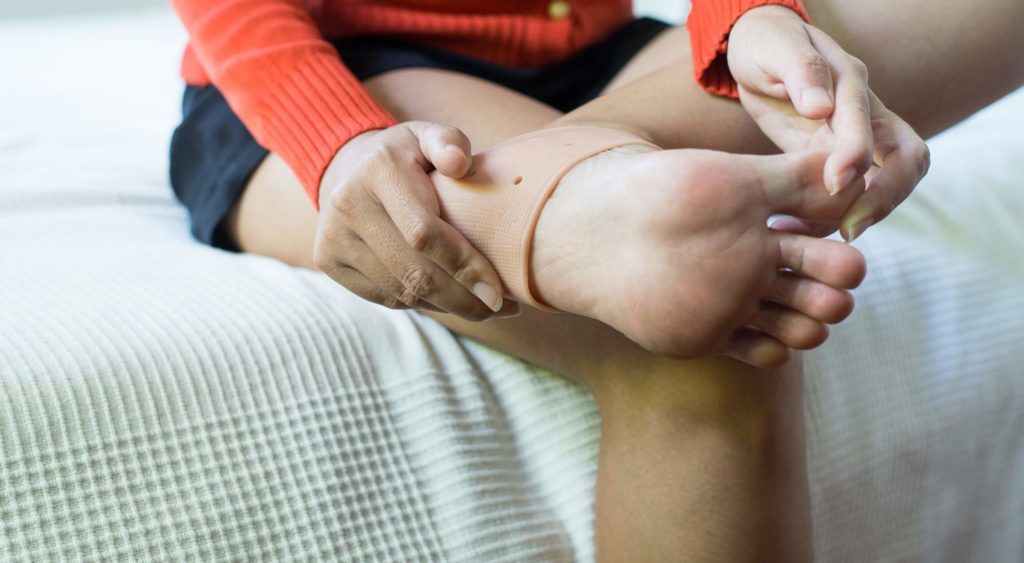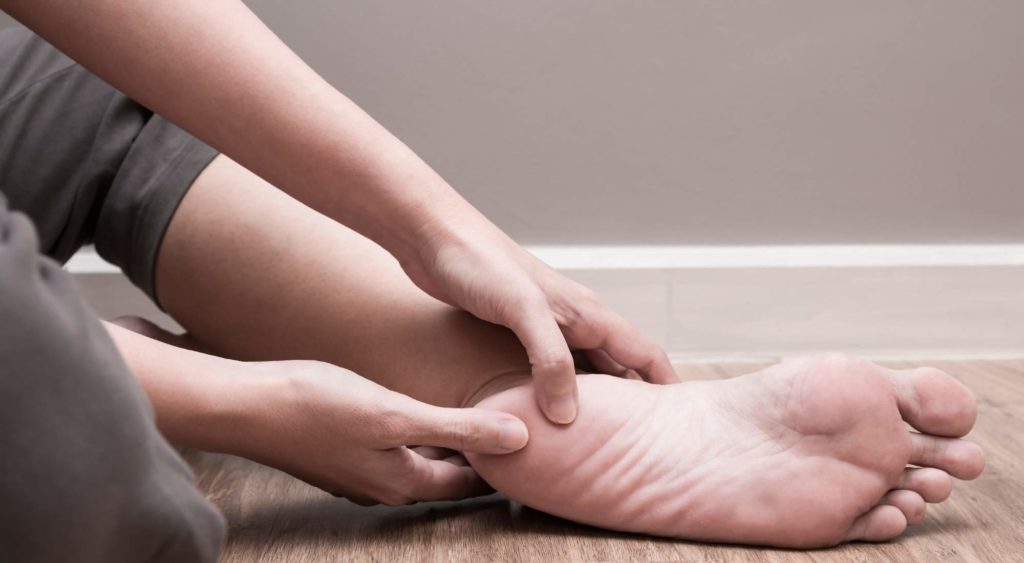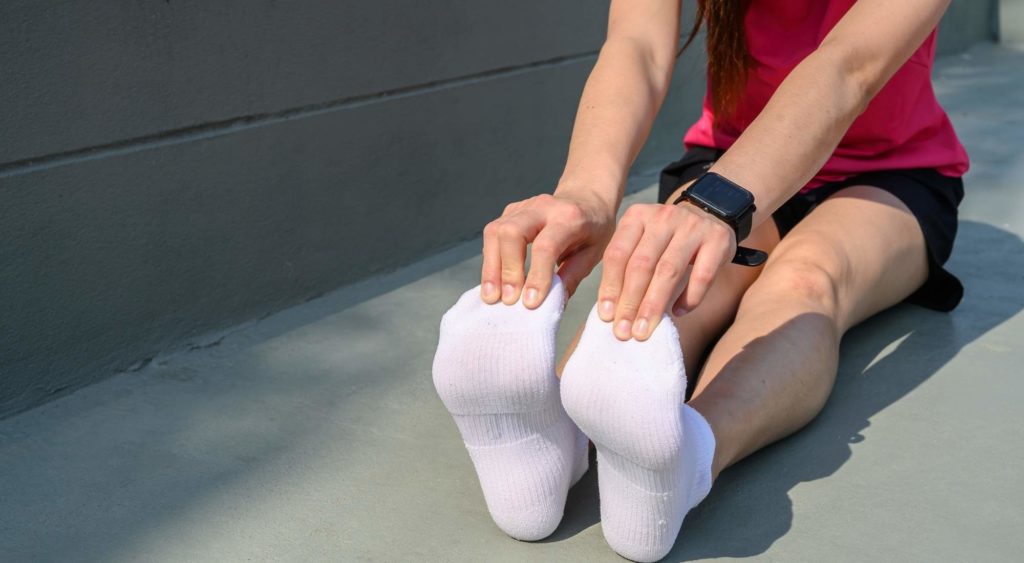
Waking up with foot pain is no joke. It makes getting out of bed more of a hurdle than it needs to be.
As you put your weight on your feet and stand up, you’re not sure why your feet hurt, again.
Is it a heel spur? Is it plantar fasciitis?
In this article, we’ll go through the differences between a heel spur and plantar fasciitis and the top recommended treatments for each.
Table of Contents
- What’s The Difference Between A Heel Spur and Plantar Fasciitis
- What Is Plantar Fasciitis?
- What Is A Heel Spur?
- What Causes A Heel Spur vs Plantar Fasciitis
- Can Heel Spurs Cause Plantar Fasciitis?
- Risk Factors For Plantar Fasciitis and Heel Spurs
- How To Tell if You Have a Heel Spur vs Plantar Fasciitis
- Heel Spur vs. Plantar Fasciitis Treatment
- Who Is In Motion O.C.?
- How In Motion O.C. Can Help You Manage Heel Spurs or Plantar Fasciitis
What’s The Difference Between A Heel Spur and Plantar Fasciitis?
You know that both heel spurs and plantar fasciitis can cause heel pain. But, are heel spurs and plantar fasciitis the same?
Long story short, no, they are different issues.
The difference between a heel spur and plantar fasciitis is that one is a calcium deposit, or bone growth (spur), and one is inflammation of a ligament.
These two issues are commonly confused with each other, though, because they can sometimes present in similar manners.
So is plantar fasciitis or bone spur causing your pain? Let’s look at the differences between these ailments.

What Is Plantar Fasciitis?
The plantar fascia is the ligament that runs along the bottom of your foot from heel to the front of your foot. This fleshy ligament acts as the shock absorber for all the pounding your feet put up with through your lifetime of walking, running, and jumping.
If the plantar fascia gets overworked or damaged, the ligament becomes inflamed and painful. Chronic or acute inflammation is called plantar fasciitis.
Plantar Fasciitis Symptoms
Plantar fasciitis symptoms can include:
- Sharp pain on the bottom of the foot or near the heel standing in the morning or after rest (“first-step pain”).
- Discomfort when stretching the foot.
- Increased pain after exercise or activity.
What Is A Heel Spur?
A heel spur is a calcium deposit on the calcaneus, or heel bone. Despite the name “spur,” it is usually not a spiky protrusion but a smooth outgrowth that has developed over a long period.
Bone spurs are growth points off of the edge of a bone. These bone spurs typically develop near joints, where two or more bones meet.
Bone spurs are fairly common as we age, and you may not even realize you have them.
Depending on their location, bone spurs can lead to pain and loss of motion in joints. Some of the most common problem areas for bone spurs are:
- Knees
- Hip
- Spine
- Shoulder
- Hands
- Foot and ankle
Here’s some good news about heel spurs, though:
One in ten people have heel spurs, but only one in twenty people with heel spurs develop heel pain.
Heel Spur Symptoms
Symptoms of heel spurs can include:
- Point of tenderness at the bottom of the heel that makes it hard to walk barefoot.
- Inflammation and swelling at the front of the heel.
- A dull ache in the heel throughout the day.
- Sharp heel pain when standing in the morning or after rest.
What Causes A Heel Spur vs. Plantar Fasciitis?
Heel spurs and plantar fasciitis have different causes and factors that trigger symptoms.
Plantar fasciitis is most commonly caused by overuse or damage to the ligament, leading to inflammation and stiffness.
Heel spurs are most commonly caused by bruising or damage to the heel bone, causing a calcium deposit to form past the edge of the bone.
Can Heel Spurs Cause Plantar Fasciitis?
Is it plantar fasciitis or a bone spur? Can one cause the other?
Luckily, it is rare for a heel spur to cause plantar fasciitis pain.
While many people with plantar fasciitis also have heel spurs, the spur is rarely the cause of the pain, so the pain can be treated without removing the spur.
To the same effect, plantar fasciitis doesn’t cause the growth of heel spurs.
And thank goodness for that.
Risk Factors For Plantar Fasciitis and Heel Spurs
Whether you’ve already gone through a foot issue or you’re trying to prevent one in the future, it’s important to know the risk factors for plantar fasciitis and heel spurs, since these are two of the most common forms of foot discomfort.
Luckily (or unluckily, depending on how you look at it), the risk factors are mostly the same for both plantar fasciitis and heel spurs.
The largest risk factors for a heel spur or plantar fasciitis are:
- Occupations that require extended periods of standing or walking
- Being overweight or obese
- Tight calf muscles
- Having high arches or flat feet
- Overuse of the foot (walking, running, or otherwise exercising the foot for a very long time)
Risk Factors For Heel Spurs
Two additional risk factors for heel spurs should be considered in addition to the above list:
- Being female: A 2014 study found heel spurs to be more common in women than in men.
- Trauma to the heel: Repetitive bruising to the heel and tearing the membrane that covers it can lead to the growth of heel spurs.
Risk Factors For Plantar Fasciitis
There are also two additional risk factors for plantar fasciitis:
- Age: Plantar fasciitis is most common in people between the ages of 40 and 60.
- Ankle Dorsiflexion: One study from Virginia Commonwealth University also found that the risk of plantar fasciitis increased when the range of motion in the ankle (ankle dorsiflexion) was reduced.

How To Tell if You Have a Heel Spur Or Plantar Fasciitis
Understanding if your heel pain comes from a heel spur or plantar fasciitis can help you start down the road to pain relief.
Plantar fasciitis is the most common cause of heel pain. Approximately 2 million patients are treated for this condition every year.
Plantar fasciitis symptoms may be felt in the arch as well as the heel. Some patients have a duller pain before they notice the stabbing heel pain.
While many people with plantar fasciitis also have heel spurs, the spurs are not usually the cause of pain.
When a heel spur is indeed responsible, the jabbing pain may be centered in the heel.
Diagnosis for both heel spurs and plantar fasciitis is mostly done through clinical examination. Schedule an appointment with your doctor to get your official diagnosis.
Imaging (such as foot x-rays and MRIs) may also be involved with the diagnosis, although they are usually used to assist in ruling out other causes for heel pain.
Heel Spur vs. Plantar Fasciitis: Treatment
Knowing the difference between a heel spur and plantar fasciitis is the first step to getting relief. Next, it’s important to proceed to treatment before your situation progresses.
In most cases, the recommended treatments for a heel spur and plantar fasciitis are consistent:
- Rest. If your doctor believes your heel pain comes from a specific high-impact activity, they will likely recommend you take a break from that activity. You’ll need to give your body a rest period to let it begin to heal.
- Ice. Icing your heel three to four times a day for 20 minutes can be very beneficial to decrease any inflammation. An easy way to do this is to freeze a water bottle and roll your heel over it.
- Proper shoes. By “proper” we mean activity-appropriate. If you’re going running, wear some running shoes. Hiking? Hiking boots are the ticket. Your doctor may also suggest shoe inserts to provide additional support.
- Calve stretches and exercises. Tight calves have been shown to highly impact heel pain. Working on stretching your calves and increasing your range of motion will help reduce pain. We at In Motion O.C. are happy to recommend physical therapy exercises to get rid of your pain.
- Night splints. When you wear a night splint your plantar fascia is consistently stretched while you sleep instead of shortening as you relax. Night splints can be especially helpful in eliminating morning soreness and pain.
If pain continues after some or all of these recommended treatments, then a surgical correction may be recommended.
The good news, however, is that up to 90% of patients succeed in eliminating their pain with conservative treatment instead of surgery.
Let’s see a recent example of plantar fasciitis in a patient:
A recent physical therapy patient, Jessica, came to us because she had a stabbing pain in her heels when she stood up to get out of bed every morning.
In this patient’s weightloss journey she had jumped into a rigorous routine of daily long-distance running.
Through a physical exam, her doctor determined that this big increase in high-impact activity had caused damage to her plantar fascia.
Jessica reduced the physical activity that was putting extra strain on her feet, got more supportive shoes, and did additional stretches for several months until her pain was gone.

Who Is In Motion O.C.?
Whether you have plantar fasciitis, pain from a heel spur, or another type of pain, physical therapy can help with your ailments.
We are Orange County’s premier physical therapy center, and we’re ready to help you overcome your pain.
Our mission is to bring hope, healing, confidence, and joy to others.
In Motion O.C. is the number one rated physical therapy center on both Yelp and Google for the entire United States.
Our physical therapists and our fitness coaches work together to not only relieve our clients’ pain but to continue to help them get strong and fit.
How In Motion O.C. Can Help You Manage Heel Spurs or Plantar Fasciitis
Rest, proper footwear, and physical therapy are the best non-surgical treatments for both heel spurs and plantar fasciitis.
If the changes you’ve made aren’t bringing you the pain relief you’re looking for then physical therapy at In Motion O.C. may be the best next step for treating your heel spur or plantar fasciitis (no pun intended).
Our physical therapy team is here to welcome new patients into the In Motion O.C. family with open arms.
We’ll help you achieve more mobility and less pain with your plantar fasciitis or heel spurs. Contact us today to get started.



